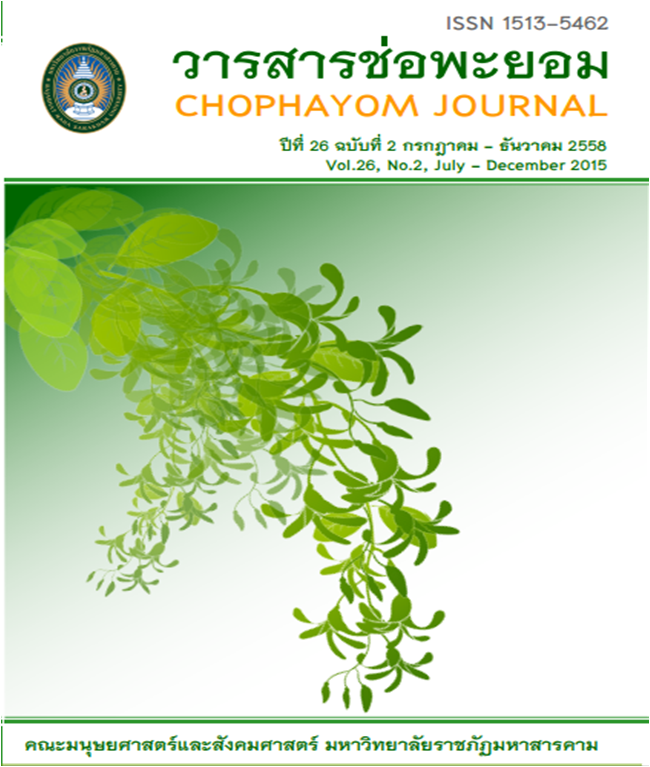การเปรียบเทียบผลการเรียนประเด็นปัญหาทางสังคมที่เกี่ยวข้องกับการใช้วิทยาศาสตร์โดยใช้การเรียนแบบผสมผสานตามรูปแบบของ Lin และ Mintzes กับรูปแบบการเรียนวัฏจักรการเรียนรู้ 5 ขั้น ที่มีต่อความสามารถในการโต้แย้งและการคิดวิพากษ์วิจารณ์ของนักเรียนชั้นมัธยมศ
บทคัดย่อ
บทคัดย่อ
การวิจัยครั้งนี้มีจุดมุ่งหมายเพื่อศึกษาและเปรียบเทียบความสามารถในการโต้แย้งและการคิด
วิพากษ์วิจารณ์หลังเรียนประเด็นปัญหาทางสังคมที่เกี่ยวข้องกับการใช้วิทยาศาสตร์ของนักเรียนชั้นมัธยมศึกษาปีที่ 2 ที่มีผลการเรียนวิทยาศาสตร์และรูปแบบการเรียนต่างกัน จำนวน 59 คน ได้มาโดยการสุ่มแบบกลุ่ม (Cluster Random Sampling) และแบ่งนักเรียนออกเป็น 2 กลุ่ม ได้แก่ กลุ่มทดลองที่ 1 จำนวน
31 คน เรียนโดยใช้การเรียนผสมผสานตามรูปแบบของ Lin และ Mintzes และกลุ่มทดลองที่ 2 จำนวน 28 คน เรียนโดยใช้การเรียนผสมผสานตามรูปแบบวัฏจักรการเรียนรู้ 5 ขั้น เครื่องมือที่ใช้ในการเก็บรวบรวมข้อมูล ได้แก่ (1) แผนการจัดการเรียนรู้ที่เรียนด้วยประเด็นปัญหาทางสังคมที่เกี่ยวข้องกับการใช้วิทยาศาสตร์ จำนวน 3 เรื่อง ได้แก่ GMO (พืชทางเลือกหรือทางร้าย) การขุดเจาะน้ำมัน (สังคมได้หรือเสียประโยชน์) และการสร้างเขื่อน (แก้น้ำท่วมหรือเบียดเบียนธรรมชาติ) โดยใช้การเรียนผสมผสานตามรูปแบบของ Lin และ Mintzes และการเรียนผสมผสานตามรูปแบบวัฏจักรการเรียนรู้ 5 ขั้น อย่างละ
3 แผน แผนละ 3 ชั่วโมงต่อสัปดาห์ (2) แบบประเมินการโต้แย้ง 4 ฉบับ ๆ ละ 4 ข้อ
(3) แบบทดสอบวัดความสามารถในการคิดวิพากษ์วิจารณ์ 4 ด้าน จำนวน 40 ข้อ สถิติที่ใช้ทดสอบสมมุติฐาน ได้แก่ Paired t-test และ F-test (Two–way MANCOVA และ ANCOVA)
ผลการวิจัยพบว่า 1) นักเรียนโดยส่วนรวม และจำแนกตามผลการเรียนวิทยาศาสตร์ หลังเรียนประเด็นปัญหาทางสังคมที่เกี่ยวข้องกับการใช้วิทยาศาสตร์ โดยใช้การเรียนผสมผสานตามรูปแบบของ Lin และ Mintzes และการเรียนผสมผสานตามรูปแบบวัฏจักรการเรียนรู้ 5 ขั้น มีการพัฒนาความสามารถ
ในการโต้แย้งเพิ่มขึ้นจากการสอบครั้งที่ 1–4 และมีการคิดวิพากษ์วิจารณ์โดยรวมและรายด้านทั้ง 4 ด้าน
เพิ่มขึ้นจากก่อนเรียน (p<.001) 2) นักเรียนที่มีผลการเรียนวิทยาศาสตร์ต่างกัน มีความสามารถในการโต้แย้งและการคิดวิพากษ์วิจารณ์โดยรวมและเป็นรายด้าน 2 ด้านไม่แตกต่างกัน (p≤.421) แต่นักเรียนที่มีผลการเรียนวิทยาศาสตร์สูงมีการคิดวิพากษ์วิจารณ์รายด้าน จำนวน 2 ด้าน คือ ด้านความสามารถในการพิจารณาความน่าเชื่อถือของแหล่งข้อมูลและการสังเกต และด้านความสามารถในการอุปนัย มากกว่านักเรียนที่มีผลการเรียนวิทยาศาสตร์ต่ำ (p≤.038) และมีความสามารถในการโต้แย้งและการคิดวิพากษ์วิจารณ์
1 นักศึกษาปริญญาโท สาขาวิทยาศาสตรศึกษา มหาวิทยาลัยมหาสารคาม
2 รองศาสตราจารย คณะวิทยาศาสตร์ มหาวิทยาลัยมหาสารคาม
3 อาจารย คณะวิทยาศาสตร์ มหาวิทยาลัยมหาสารคาม
โดยรวมและเป็นรายด้าน 3 ด้านไม่แตกต่างกัน (p=.138) แต่นักเรียนที่เรียนโดยใช้การเรียนผสมผสานตามรูปแบบของ Lin และ Mintzes มีการคิดวิพากษ์วิจารณ์ด้านความสามารถในการพิจารณาความน่าเชื่อถือของแหล่งข้อมูลและการสังเกตมากกว่านักเรียนที่เรียนโดยใช้การเรียนผสมผสานตามรูปแบบวัฏจักรการเรียนรู้ 5 ขั้น (p=.016) 4) ไม่มีปฏิสัมพันธ์ระหว่างผลการเรียนวิทยาศาสตร์กับรูปแบบการเรียนต่อความสามารถในการโต้แย้งและการคิดวิพากษ์วิจารณ์โดยรวมและเป็นรายด้าน 3 ด้าน (p≥.177) แต่มีปฏิสัมพันธ์ระหว่างผลการเรียนวิทยาศาสตร์กับรูปแบบการเรียนต่อการคิดวิพากษ์วิจารณ์รายด้านในด้านความสามารถในการพิจารณาความน่าเชื่อถือของแหล่งข้อมูลและการสังเกต (p=.018)
คําสําคัญ : ประเด็นปัญหาทางสังคมที่เกี่ยวข้องกับการใช้วิทยาศาสตร์, การเรียนแบบผสมผสาน,
การโต้แย้ง, การคิดวิพากษ์วิจารณ์
ABSTRACT
This research was aimed to study and compare argumentation and critical thinking abilities after learning socioscientific issues of fifty–nine Mathayomsuksa 2 students with different science learning outcomes and learning methods who were selected using the cluster random sampling technique. They were divided into 2 groups : the first experimental group of 31 students learned using the mixed methods based on Lin and Mintzes method and the second experimental group of
28 students learned using the mixed methods based on the 5E learning cycle approch. Research instruments included (1) learning plans on 3 socioscientific issues Genetically Modified Organisms (Alternative or Destructive Plants), Petroleum Drilling (Advantages or Disadvantages for Socity), and Dam Construction (Flood Prevention or Natural Damage), using the mixed methods based on the Lin and Mintzes method and the 5E learning cycle approch, 3 plans each and each plan for 3 hours of learning in a week ; (2) 4 argumentation tests, 4 items each ; and (3) the critical thinking test with 4 subscales, and 40 items : credibility of sources and observation, deduction, induction and assumption identification. The collected data were analyzed for testing hypotheses using the paired t–test and the F–test (Two–way MANCOVA and ANCOVA).
The major findings revealed that the students as a whole and as classified according to science learning outcome and learning method who learned using the mixed methods based on the Lin and Mintzes method and the 5E learning cycle approch showed developments in argumentation from the 1st test to the 4th test ; and showed gains in critical thinking abilities in general and in 4 subscales from before learning (p<.001). The students with different science learning outcomes did not show different argumentation and critical thinking abilities in general and in 2 subscales after learning socioscientific issues (p≤.421). But the high science achievers indicated more critical thinking abilities in 2 subscales : credibility of sources and observation and induction, than the low science achievers (p≤.038). The students with different learning methods did not show different argumentation and critical thinking abilities in general and in 3 subscales after learning socioscientific issues (p=.138). But the first experimental group students showed more critical thinking abilities in credibility of sources and observation than the second experimental group students (p=.016). In addition, the statistical interactions of science learning outcomes with learning methods on argumentation and critical thinking abilities in general and in 3 subscale were not found to be significant (p≥.177). But there was a statistical interaction of the two variables on critical thinking abilities in credibility of sources and observation (p=.018).
Key words : Socioscientific Issues, The Mixed Methods, Argumentation,
Critical Thinking






